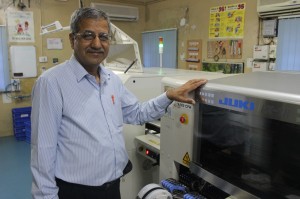Text & Photos: J Srikant
The automotive industry in India is moving fast towards increasing use of electronics in vehicles. Not just cars, even the 2-wheeler segment is getting more electronics fitted into their vehicles. One of the earliest electronic features to be used in a 2-wheeler was the flasher when it was made mandatory by the Motor Vehicle Act around 1985. However, the dilemma that many companies faced at that time was that there were no Indian players who could manufacture the flasher.
 Sensing an opportunity, Yogendra S Natu, an auto electronics expert, who had relevant experience and deep knowledge of the industry, decided to provide this solution to 2-wheeler manufacturers. Thus was born Auto Electronics India in 1985. Prior to this, Natu was with Bajaj where he worked on the flasher; he also had a small stint with Automotive Research Association of India (ARAI). Today, Auto Electronics is one of the known Indian names for giving electronic solutions to the automotive industry. After making a mark for itself in the 2-wheeler segment, Auto Electronics is now planning a foray into 4-wheelers.
Sensing an opportunity, Yogendra S Natu, an auto electronics expert, who had relevant experience and deep knowledge of the industry, decided to provide this solution to 2-wheeler manufacturers. Thus was born Auto Electronics India in 1985. Prior to this, Natu was with Bajaj where he worked on the flasher; he also had a small stint with Automotive Research Association of India (ARAI). Today, Auto Electronics is one of the known Indian names for giving electronic solutions to the automotive industry. After making a mark for itself in the 2-wheeler segment, Auto Electronics is now planning a foray into 4-wheelers.
“We are seriously contemplating entering into 4-wheeler segment as well, now that a lot of car manufacturers are localising manufacturing,” Natu said. According to him, although 2-wheeler electronics was made in India, car electronics were mostly imported, which is now about to change. Auto Electronics product portfolio includes electronic igniters, flashers, body control units, engine control units, voltage regulators, Digital DC CDI, Digital AC CDI, Digital AC CDI Cum Flasher, Analog AC CDI, 12V Rectifier cum Regulator, AC Regulator cum Flasher, 12V Battery Charger for rickshaw, and AC/DC converter.
Auto Electronics, whose first customer was Surya scooters based in Kanpur, today has major companies like TVS, Greaves, Majestic Auto and other Tier-1 & Tier-2 companies in its client list. The Pune-based electronics company said they have a presence only in the 2-wheeler and 3-wheeler segment, with indirect supplies to 4-wheeler and commercial vehicle segments.
Apart from manufacturing electronic components for OEMs, Tier-1 and Tier-2 companies, Auto electronics does contract manufacturing for other players in the industry. Called the Electronic Manufacturing Services (EMS), Natu says this is one of his ways to give back to society. “Through this initiative we can help the smaller companies who don’t have the expensive machines to carry out manufacturing. We get a lot of such requests. Also, it gave us business when the market was slightly down.” However, he said the company hardly felt the impact of the recent slowdown, primarily because they are into the 2-wheeler segment, which performed steadily unlike the 4-wheel sector.
According to Natu, electronics is going to be the next big thing in the auto component space. Right from improving performance and efficiency to even reducing emissions, electronics is going to play a major role. Stressing on the upcoming tighter norms, he said electronics would be instrumental in controlling emissions, and that is where most of the R&D would happen.
Auto Electronics has an installed capacity of producing 5 million units per annum. At present, production at the 10,000 sq ft manufacturing facility stands at 3 million units per annum. With the market expected to pick up again, the company is hoping to utilise the rest of the capacity as well. Despite the fact that Auto Electronics has an eye on the 4-wheeler segment, Natu does not expect any dearth in demand from the 2-wheeler side. “The use of advanced electronics is already happening in the two-wheeler and we will see lot more of it in the near future. In the long-run, whatever technology we will see in cars, will percolate down to 2-wheelers as well,” Natu opined.

Another area that the company was missing from, but now is looking at, is direct exports. Natu claimed they have been receiving queries from other countries but did not look at it seriously until now. “We have not been into exports up till now. But after the sudden spike in dollar rates last year, we realised that we have to export as well if we need to offset the losses in the domestic market,” he added.











Leave a Reply